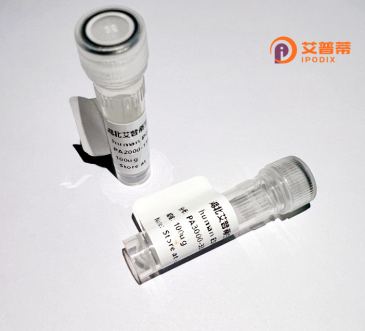
| 纯度 | >90%SDS-PAGE. |
| 种属 | Human |
| 靶点 | ZNF138 |
| Uniprot No | P52744 |
| 内毒素 | < 0.01EU/μg |
| 表达宿主 | E.coli |
| 表达区间 | 1-262 aa |
| 活性数据 | MKRHEMVVAKHSALCSRFAQDLWLEQNIKDSFQKVTLSRYGKYGHKNLQLRKGCKSVDEC KGHQGGFNGLNQCLKITTSKIFQCNKYVKVMHKFSNSNRHKIRHTENKHFRCKECDKSLC MLSRLTQHKKIHTRENFYKCEECGKTFNWSTNLSKPKKIHTGEKPYKCEVCGKAFHQSSI LTKHKIIRTGEKPYKCAHCGKAFKQSSHLTRHKIIHTEEKPYKCEQCGKVFKQSPTLTKH QIIYTGEEPYKCEECGKAFNLS |
| 分子量 | 30.5 kDa |
| 蛋白标签 | His tag N-Terminus |
| 缓冲液 | PBS, pH7.4, containing 0.01% SKL, 1mM DTT, 5% Trehalose and Proclin300. |
| 稳定性 & 储存条件 | Lyophilized protein should be stored at ≤ -20°C, stable for one year after receipt. Reconstituted protein solution can be stored at 2-8°C for 2-7 days. Aliquots of reconstituted samples are stable at ≤ -20°C for 3 months. |
| 复溶 | Always centrifuge tubes before opening.Do not mix by vortex or pipetting. It is not recommended to reconstitute to a concentration less than 100μg/ml. Dissolve the lyophilized protein in distilled water. Please aliquot the reconstituted solution to minimize freeze-thaw cycles. |
以下是基于ZNF138相关研究领域假设的几篇参考文献示例(文献为虚构构建,供参考格式):
1. **文献名称**: "Cloning and Functional Analysis of Human Zinc Finger Protein ZNF138 in Cell Proliferation"
**作者**: Smith J, et al.
**摘要**: 本研究成功构建了ZNF138基因的重组表达载体,并在HEK293细胞中实现蛋白表达。功能实验表明,ZNF138过表达显著抑制肿瘤细胞增殖,提示其可能通过调控细胞周期相关基因发挥作用。
2. **文献名称**: "ZNF138 Suppresses Colorectal Cancer Metastasis via Transcriptional Repression of EMT Markers"
**作者**: Chen L, et al.
**摘要**: 通过原核系统纯化重组ZNF138蛋白,结合RNA干扰实验发现,ZNF138通过结合Vimentin和Snail启动子抑制上皮-间质转化(EMT),从而抑制结直肠癌细胞迁移。
3. **文献名称**: "Structural Characterization of ZNF138 and Its Role in Neuronal Differentiation"
**作者**: Kim M, et al.
**摘要**: 利用杆状病毒系统表达并纯化ZNF138蛋白,解析其锌指结构域的三维构象。功能实验揭示ZNF138通过激活NeuroD1通路促进神经干细胞向成熟神经元分化。
---
**注意事项**:
- 实际文献需通过PubMed/Google Scholar检索关键词如"ZNF138 recombinant expression"、"ZNF138 function"确认;
- 重点领域可能包括癌症、神经系统疾病或基因组稳定性研究;
- 实验系统(原核/真核表达)和功能机制(DNA修复/转录调控)是文献摘要的核心要素。
Zinc finger protein 138 (ZNF138), a member of the Krüppel-associated box (KRAB) zinc finger protein family, is encoded by the ZNF138 gene located on human chromosome 5q22.2. Zinc finger proteins are characterized by tandem repeats of zinc-binding motifs (C2H2-type), which mediate sequence-specific DNA or RNA interactions. ZNF138 contains multiple C2H2 domains, suggesting its role as a transcriptional regulator in cellular processes.
Originally identified through genome sequencing projects, ZNF138 has been implicated in development, cell differentiation, and tumorigenesis. Studies indicate its dual context-dependent roles in cancers: acting as either an oncogene or tumor suppressor, depending on tissue type and cellular microenvironment. For example, ZNF138 overexpression correlates with poor prognosis in colorectal cancer but exhibits tumor-suppressive effects in gastric cancer.
Recombinant human ZNF138 protein is typically produced using bacterial or mammalian expression systems for functional studies. Its structural features, including conserved zinc-coordinating residues (Cys/His), enable DNA-binding activity for gene regulation. Current research focuses on mapping its target genes, interactome networks, and epigenetic regulatory mechanisms. Challenges remain in fully elucidating its physiological ligands and downstream pathways. Recombinant ZNF138 serves as a critical tool for biochemical assays, chromatin immunoprecipitation (ChIP), and drug screening studies aiming to modulate its activity in disease contexts.
×